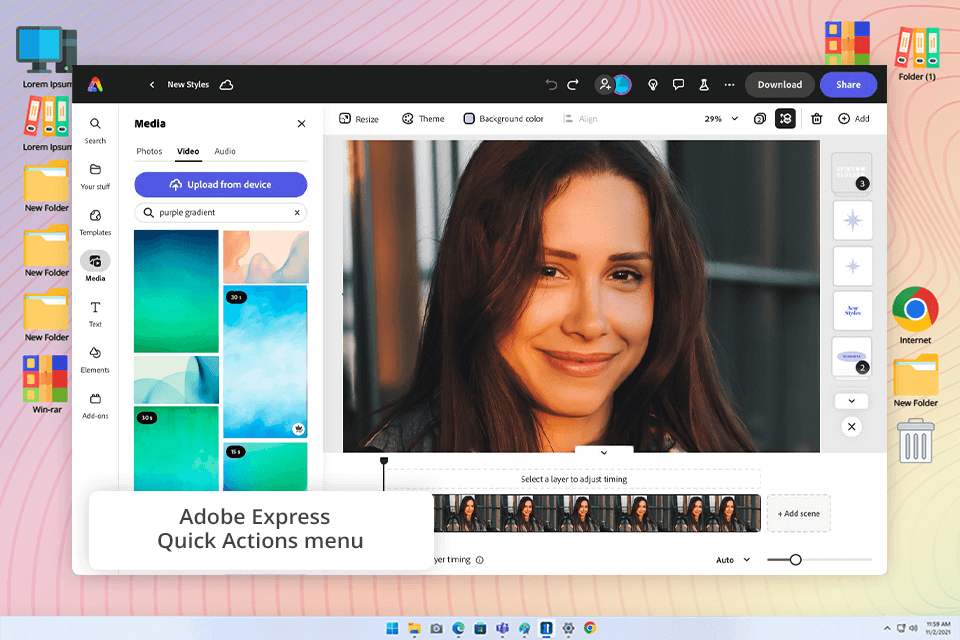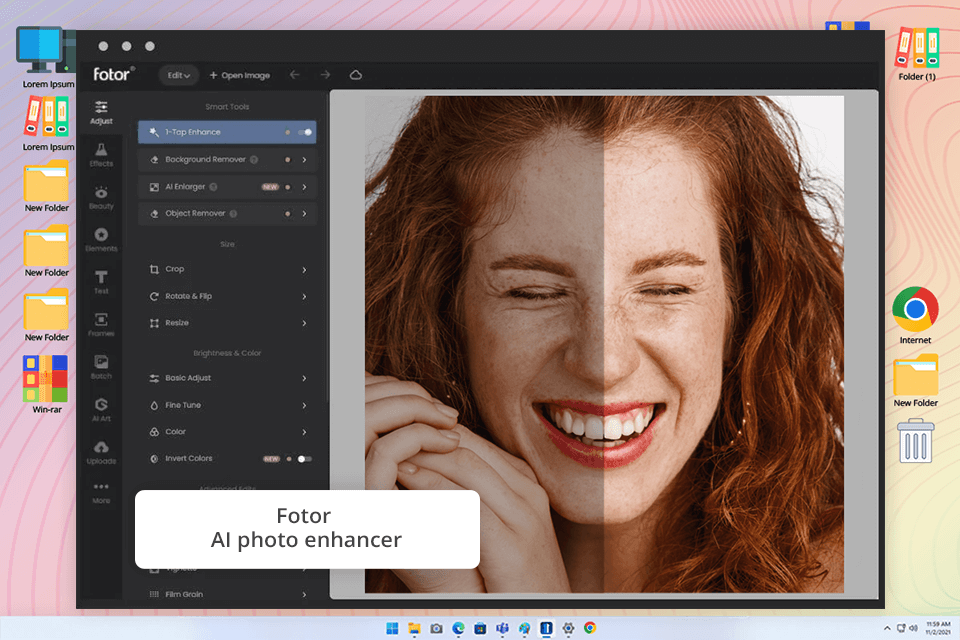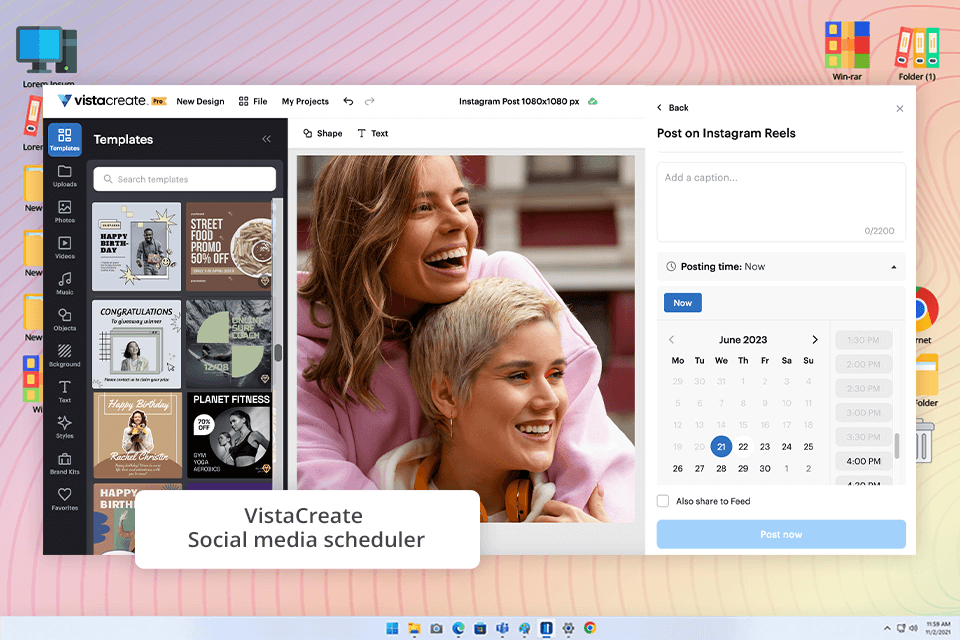I’ve tried many DesignCap alternatives recently. I work as a graphic designer for FixThePhoto. For years, it was my first choice for making quick ads, posters, and presentations for clients.
It was easy to use and worked well at first, but when my projects became harder, I needed more ways to change designs, team tools, and file types. That’s when problems became clear.
For the last two months, I’ve searched a lot, looking through Reddit posts, watching many YouTube reviews, and asking my colleagues for ideas. I want to find a free DesignCap alternative, or at least one good enough to buy.
After trying over testing more than 35 DesignCap alternatives, I’ve chosen my top picks. These aren’t random; they’re tools that are truly better than DesignCap for customizing designs, having more creative choices, and being easier to use.
DesignCap is an online tool for making posters, flyers, charts, and other designs quickly without expert skills. For years, it was my fast solution for ads and client slides, especially when my time was restricted. But over time, it stopped giving me the results I needed.
How to pick the best DesignCap alternative for your requirements:

When my coworker and some Reddit users recommended Adobe Express as a DesignCap alternative, I decided to try it. I tested it on three actual client jobs: social media ads, a printed flyer, and a short moving ad.
I began using its ready-made designs and immediately saw that they offered way more flexibility than DesignCap. I could change any text area, instantly swap all colors, and even add small moving touches without messing up the layout. Plus, having Adobe Stock built right in saved me loads of time searching for images.
At first, it ran slower than DesignCap and took me some time to find all the tools. But after learning it, I discovered it does the work of three other programs I used separately before.
One tool from the recent update I like automatically changes image sizes. I used it to quickly fix photos for Instagram - it made the background bigger without stretching or cutting the picture. This saved me from opening Photoshop just to make them ready for Instagram.
Price: Adobe Express free plan or $9.99/mo

I learned about Visme on Reddit, where people said it’s best for presentations and charts. I wanted to see if this Visme online design software could be better than DesignCap for those tasks. So, I tested it by completely redoing an old infographic project.
Right away, I saw that Visme worked better - it let me control charts and graphs more easily. I could create charts where people point at parts to see extra information. DesignCap and many other Visme alternatives can’t do this at all.
I also used it for a client presentation. The way you can move between slides, add moving parts, and easily line things up made the work quicker and the final deck look much more professional. The main downside was that it could run slowly - when I had bigger files with several charts, the browser would often struggle. Still, for coming up with creative ideas, it’s a big improvement.
I was surprised to find I could put videos, clickable links, and live polls directly into my work. Testing it myself showed me a whole new level of interaction I’d been missing. It completely changed my idea of how engaging a basic infographic can be.
Pricing: Free limited plan; Paid from $25/mo

I kept seeing Fotor on YouTube lists of the best free design tools. I wanted to see if it was a good DesignCap alternative for projects that use a lot of photos. I tried it out by making a wedding photo flyer, a before-and-after collage for a tutorial, and some Facebook ads.
I was immediately impressed by the built-in photo editor. It let me make detailed changes to light, darkness, and skin colors all in one place, so I didn’t need to use Photoshop. The controls were far more exact than DesignCap’s, and this precision saved me hours of work on ads that needed perfectly matching colors.
While Fotor’s template selection isn’t as large as Canva’s, its designs are higher quality than DesignCap’s and simpler to adjust for your brand. However, the free plan places watermarks on premium graphics, and I often had to re-save my work in a new size to meet different platform rules.
If your project is all about the photos, Fotor is the better choice. It combines a simple design tool with a good photo editor. This is a feature I always wanted DesignCap to have.
Pricing: Free version; Paid from $9.99/mo


After comparing Canva vs DesignCap to see which one was better, I immediately understood why everyone recommends Canva. I tried it out by making three things: a thumbnail for a YouTube video, a post for Instagram, and a program for an event.
It was very easy to use from the beginning. I could just drag and drop pictures and text. Also, I could work together with my teammate and see their changes live. It has more templates than any other app, and suggests designs and colors for you, which helps me work much faster.
Another highlight for me was Canva photo editor, which allowed applying quick filters, removing backgrounds, and correcting lighting without using Photoshop.
The main downside is that Canva can be overwhelming initially because it offers so many features. However, after I set up my brand assets and organized my templates, it turned into a central tool for all my design needs, from social media to professional presentations.
Pricing: Free plan available; Paid from $15/mo

My colleague suggested I use VistaCreate as a DesignCap alternative. I tested it by making animated stories for Instagram, pins for Pinterest, and a banner for LinkedIn. The first thing I noticed was its collection of moving templates. These are much more dynamic than the static options on DesignCap, and they are perfect for holding your audience’s interest.
VistaCreate seems made for marketers who want to work quickly but still make stylish content. This makes it better than VistaCreate alternatives. I also saved time by using its built-in scheduler to post directly to my social media accounts.
I tested their free AI selfie generator as well. It was surprisingly good at creating pictures and a lot of fun to use. It helped me add my own personal style to my content.
The downsides are that some animations are limited, and the layout can feel overwhelming until you learn it. But overall, the benefits are much stronger. The animated templates, huge library of photos, and direct publishing feature make it a very practical and creative tool.
Pricing: Free starter plan; Paid from $10/mo

I learned about Piktochart from YouTube, where it was recommended as a better option than DesignCap for creating infographics. To test it, I used it for three projects: I redesigned an old blog graphic, created an annual report for my company, and made a series of posts for social media.
The tool is clearly focused on layouts and turning data into visuals. I easily put my numbers in, and they were automatically formatted into clean, professional charts. This is something that makes it stand out from more generic DesignCap and Piktochart alternatives.
I liked that it was easy to use, but still let me change things. I could adjust colors, fonts, and the layout, and everything still looked good together. Also, the files are downloaded in high quality, perfect for both websites and printed materials.
The one downside is that the content creation app isn’t the quickest tool for simple projects. When you’re creating a basic design that doesn’t involve charts or data, using it can feel like using a giant tool for a small job.
Pricing: Free limited plan; Paid from $14/mo

Based on suggestions from forums users, I tested Desygner for a project where the client had strict branding rules. I immediately noticed how easy it was to create a brand kit. Once I set the logos, colors, and fonts, they were automatically added to any template I used.
It was much faster than DesignCap and eliminated hours of boring, repetitive work. Another feature I enjoyed was the ability to edit across devices. I could begin a project on my laptop and make final adjustments on my phone, and all the tools worked the same.
It doesn’t have as many pre-made designs as Canva or other alternatives to Desygner. But the designs it does have are better for business and ads. The bad parts are that it can get slow when you use big pictures, and you have to pay to use some of the best photos and graphics.
Pricing: Free plan; Paid from $10/mo

A coworker told me that Snappa is a simpler DesignCap alternative. I tested it to see how fast it was. My test was to make five different versions of a Facebook ad in less than an hour. I finished them all with time left over.
The interface is basic but very efficient, which is great for quick projects. I was especially impressed with the resizing feature. It let me instantly customize a Facebook ad for other platforms like Instagram or LinkedIn without any extra work.
It also has free photos you can use right inside the app, so you don’t have to search for them on other websites. When I compared Adobe Creative Cloud Express vs Snappa, Snappa had fewer tools but was much quicker for simple projects.
The biggest problem is that the free version only lets you download a few designs each month, which is a common issue with other Snappa alternatives.
Pricing: Free limited plan; Paid from $10/mo

I learned about Easil from a YouTube video about marketing tools for small businesses. I was interested, so I tried this DesignCap alternative out. For a workshop I was hosting, I made flyers, tickets, and a set of Instagram stories to promote it.
Right from the start, I noticed Easil’s templates were special. They felt more unique and stylish than DesignCap’s basic ones. I really liked the extra design tools, like the color picker and cool text effects. They helped my work look professional without needing another app.
The editor was easy to use. You can just drag and drop things where you want them. I also liked the text options much more than in other tools. As for minuses, some useful features, like working together with a team on the same design, are only available if you pay. Also, saving large, high-quality pictures took a long time.
Pricing: Limited free trial; Paid plans from $11/mo
When I put this list together, my aim wasn’t just to gather design tools based on features or marketing hype - it was to find options that truly do better than DesignCap in the areas where it’s weak
I used these tools for many jobs: social media posts, event advertisements, and slides for clients. I worked alone and also with my FixThePhoto teammates, who are experts in marketing design. We tested everything carefully. We didn’t just try the tools quickly; we used each one for at least three real projects to see how they performed under tight deadlines.
My goal was to find a free DesignCap alternative that offered more modern templates, greater control over editing, and a smoother user experience. I tested each option by completing real-world tasks like creating social ads, flyers, and client decks - the same kind of work I usually do in DesignCap.
Each tool was evaluated based on:
The whole testing process took almost a month. I compared the tools a lot and learned from my mistakes. In the end, I understood which tools were good enough for real, professional work and which ones were only okay for quick, simple designs.
Not every tool I tested made it into my final top picks:
The tools in this review are all better than DesignCap. They let you create more freely and make things that look more professional. They are real improvements, not just different options.